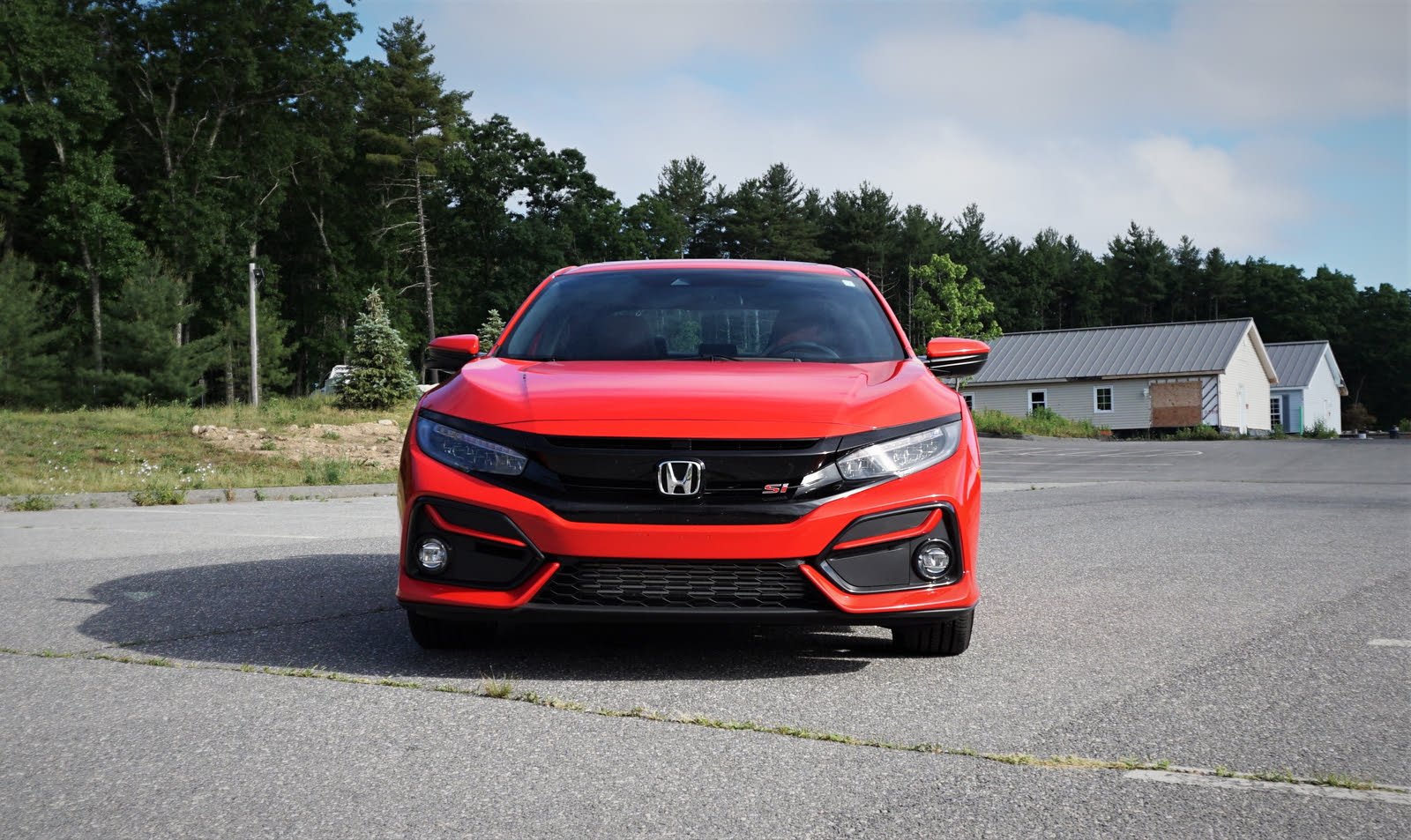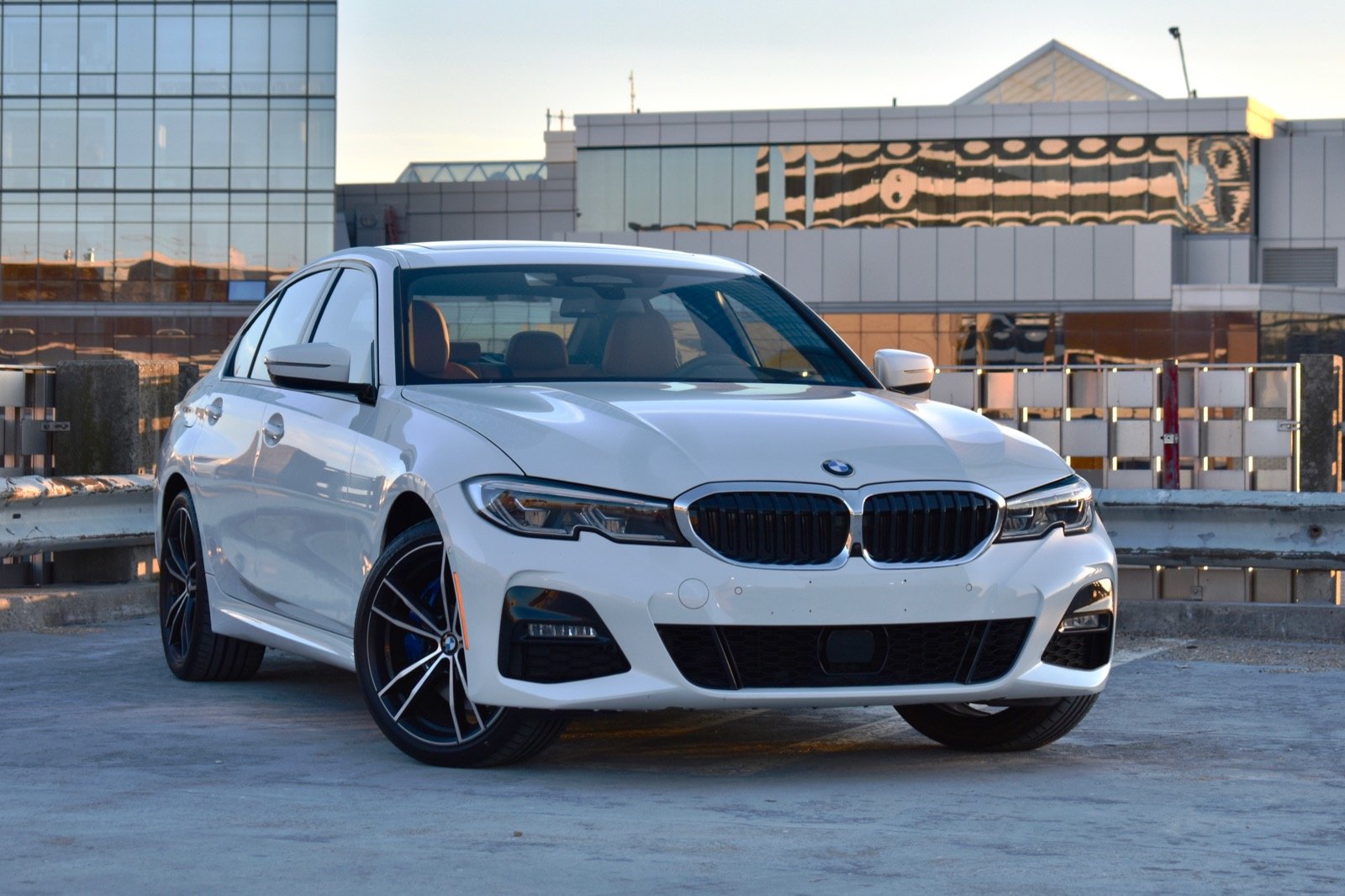2020 Honda Civic vs 2021 BMW 3 Series
Overview | |
MSRP$20,000 | MSRP$41,250 |
Listings1577 | Listings573 |
Ratings & Reviews | |
User Reviews | User Reviews |
Expert reviews8.2 out of 10 | Expert reviews6.8 out of 10 |
Pros
Cons
| Pros
Cons
|
2020 Honda Civic Reviews SummaryMinor design tweaks, more standard safety and convenience features, and more manual transmissions arrive as the standout changes for the Civic's 2020 model year. Last redesigned for the 2016 model year, the Civic keeps outperforming its small-car peers by offering the performance and quality of more expensive cars, while retaining the value and longevity expected of a Honda. Plus, I had a really fun week with the turbocharged Civic Si. | |
2021 BMW 3 Series Reviews SummaryEarly generations of the BMW 3 Series redefined what a luxury car could be, justifying their prestige badge with sporty driving dynamics and impeccable engineering. BMW changed the luxury-car paradigm, proving that nimble sports sedans could be just as desirable as wood-encrusted land yachts. The 3 Series spawned a number of imitators, including the Audi A4, Mercedes-Benz C-Class, and Lexus IS. Those sedans, along with the Acura TLX, Alfa Romeo Giulia, Cadillac CT4, and Infiniti Q50 (which wear more recently-introduced nameplates) still form the 3 Series’ competitive set, but the car itself has changed. Introduced for the 2019 model year, the current-generation 3 Series (codenamed G20) feels more like a traditional luxury sedan, with a greater emphasis on comfort and convenience than previous generations. The manual transmission is gone, as are the wagon and 3 Series GT hatchback body styles. The 3 Series coupe and convertible were re-badged as the 4 Series beginning with the 2014 model year. The biggest change for the 2021 BMW 3 Series is the addition of the 330e plug-in hybrid model to the lineup, so that’s what we test drove for this review. BMW also offers 330i and M340i versions, and there’s an M3 performance model on the way. | |
No video found | |
Popular Features & Specs | |
Engine2.0L 158 hp I4 | Engine2.0L 255 hp I4 |
Drive TrainFWD | Drive TrainRWD |
Seating Capacity5 | Seating Capacity5 |
Horsepower158 hp @ 6500 rpm | Horsepower255 hp @ 5000 rpm |
MPG City25 | MPG City26 |
MPG Highway36 | MPG Highway36 |
Engine | |
Engine Name2.0L 158 hp I4 | Engine Name2.0L 255 hp I4 |
Torque138 lb-ft @ 4200 rpm | Torque295 lb-ft @ 1450 rpm |
Horsepower158 hp @ 6500 rpm | Horsepower255 hp @ 5000 rpm |
DrivetrainFWD | DrivetrainRWD |
Fuel Economy | |
MPG City25 | MPG City26 |
MPG Highway36 | MPG Highway36 |
Interior | |
Seating Capacity5 | Seating Capacity5 |
Key Features | |
Navigation System | Navigation SystemStandard |
Sunroof/Moonroof | Sunroof/MoonroofStandard |
Safety | |
Front Crash Overall5 | Front Crash Overall5 |
Side Crash Overall5 | Side Crash Overall5 |
Dimensions & Capacity | |
Cargo Space15.1 cu ft | Cargo Space13.0 cu ft |
Curb Weight2762 lbs | Curb Weight3589 lbs |
Height55.7 in | Height56.8 in |
Length182.7 in | Length185.7 in |
Width70.8 in | Width81.4 in |
Wheelbase106.3 in | Wheelbase112.2 in |
Maximum Payload1007 lbs | Maximum Payload |
Number of doors4 | Number of doors4 |
Overview | ||
MSRP | $20,000 | $41,250 |
Listings | ||
Ratings & Reviews | ||
User reviews | ||
Expert reviews | 8.2 out of 10Read full review | 6.8 out of 10Read full review |
Pros & cons | Pros
Cons
| Pros
Cons
|
Summary | Minor design tweaks, more standard safety and convenience features, and more manual transmissions arrive as the standout changes for the Civic's 2020 model year. Last redesigned for the 2016 model year, the Civic keeps outperforming its small-car peers by offering the performance and quality of more expensive cars, while retaining the value and longevity expected of a Honda. Plus, I had a really fun week with the turbocharged Civic Si. | Early generations of the BMW 3 Series redefined what a luxury car could be, justifying their prestige badge with sporty driving dynamics and impeccable engineering. BMW changed the luxury-car paradigm, proving that nimble sports sedans could be just as desirable as wood-encrusted land yachts. The 3 Series spawned a number of imitators, including the Audi A4, Mercedes-Benz C-Class, and Lexus IS. Those sedans, along with the Acura TLX, Alfa Romeo Giulia, Cadillac CT4, and Infiniti Q50 (which wear more recently-introduced nameplates) still form the 3 Series’ competitive set, but the car itself has changed. Introduced for the 2019 model year, the current-generation 3 Series (codenamed G20) feels more like a traditional luxury sedan, with a greater emphasis on comfort and convenience than previous generations. The manual transmission is gone, as are the wagon and 3 Series GT hatchback body styles. The 3 Series coupe and convertible were re-badged as the 4 Series beginning with the 2014 model year. The biggest change for the 2021 BMW 3 Series is the addition of the 330e plug-in hybrid model to the lineup, so that’s what we test drove for this review. BMW also offers 330i and M340i versions, and there’s an M3 performance model on the way. |
Video | No video found | |
Popular Features & Specs | ||
Engine | 2.0L 158 hp I4 | 2.0L 255 hp I4 |
Drive Train | FWD | RWD |
Seating Capacity | 5 | 5 |
Horsepower | 158 hp @ 6500 rpm | 255 hp @ 5000 rpm |
MPG City | 25 | 26 |
MPG Highway | 36 | 36 |
Engine | ||
Engine Name | 2.0L 158 hp I4 | 2.0L 255 hp I4 |
Torque | 138 lb-ft @ 4200 rpm | 295 lb-ft @ 1450 rpm |
Horsepower | 158 hp @ 6500 rpm | 255 hp @ 5000 rpm |
Drivetrain | FWD | RWD |
Fuel Economy | ||
MPG City | 25 | 26 |
MPG Highway | 36 | 36 |
Interior | ||
Seating Capacity | 5 | 5 |
Key Features | ||
Navigation System | Standard | |
Sunroof/Moonroof | Standard | |
Safety | ||
Front Crash Overall | 5 | 5 |
Side Crash Overall | 5 | 5 |
Dimensions & Capacity | ||
Cargo Space | 15.1 cu ft | 13.0 cu ft |
Curb Weight | 2762 lbs | 3589 lbs |
Height | 55.7 in | 56.8 in |
Length | 182.7 in | 185.7 in |
Width | 70.8 in | 81.4 in |
Wheelbase | 106.3 in | 112.2 in |
Maximum Payload | 1007 lbs | |
Number of doors | 4 | 4 |
The 2020 Honda Civic was a standout in Honda's lineup, offering a level of engineering excellence typically found in more expensive brands like BMW. Despite being a $20,000 compact car, it came in three body styles—sedan, coupe, and 4-door hatchback—each showcasing a sharp design that belied its small footprint. The sedan featured an elegant, elongated body with a svelte roofline, while the hatchback had a quirky tall rump. The 2019 model year brought upgrades to the grilles, bumpers, and wheels, which carried over into 2020. The Civic Si sedan and coupe received new matte-black 18-inch wheels, LED fog lights, and standard LED headlights. The interior was simple yet high-quality, with soft-touch rubbers, high-quality switchgear, and pleasing gloss-black trim.
In contrast, the 2021 BMW 3 Series returned to a traditional familial look, reminiscent of the classic E30 3 Series. However, the G20 3 Series appeared stuffy, with a big, oddly-shaped grille that didn't quite fit the smaller sedan. The interior design was nice but marred by unimpressive materials, with plastic trim and fake-looking Ash wood. Leather upholstery was optional, and the standard synthetic Sensatec material felt basic. The M Sport trim package added some flair with M 19-inch wheels and blue-painted brake calipers, but the overall design lacked the luxurious feel expected from a BMW.











The 2020 Honda Civic offered a range of engines and transmissions, all front-wheel drive. The base LX and Sport trims had a 2.0-liter inline 4-cylinder engine with 158 horsepower and 138 pound-feet of torque, paired with a 6-speed manual transmission or an optional CVT. The EX and higher trims featured a turbocharged 1.5-liter inline-4 engine, producing 174 hp and 162 lb-ft, with the hatchback versions making 180 hp. The Civic Si had a boosted 1.5-liter engine with 205 hp and 192 lb-ft, while the Type R boasted 306 hp and 295 lb-ft. The Si and Type R came exclusively with a stick-shift. The Civic's powertrains were smooth and responsive, with the Si offering a thrilling yet balanced driving experience. The EPA rated the Si at 26 mpg city, 36 mpg highway, and 30 mpg combined.
The 2021 BMW 3 Series featured three powertrains: a 2.0-liter turbocharged four-cylinder engine with 255 hp and 295 lb-ft, a 330e plug-in hybrid with a combined 288 hp and 310 lb-ft, and a turbo inline-six in the M340i with 382 hp and 369 lb-ft. All models came with an eight-speed automatic transmission and were available with rear-wheel drive or xDrive all-wheel drive. The M340i could accelerate from zero to 60 mph in 4.2 seconds, while the base 330i took 5.6 seconds. The 330e matched the 330i's acceleration time despite its extra weight. However, the 330e's transition from electric to gasoline power was clunky, and the overall driving experience lacked the engagement of past 3 Series models.
The 2020 Honda Civic's interior featured a volume knob and better cupholders, with more sound insulation in the hatchback. The EX hatchback had an eight-way power-adjustable driver's seat. The three-spoke steering wheel had controls for the central display and instrument panel, and the center console offered configurable storage. The Civic felt roomy for rear passengers, though it lacked rear air vents. The sedan's trunk had 15 cubic feet of cargo space, while the coupe had 12 cubic feet. The hatchback offered 26 cubic feet behind the rear seats and 46 cubic feet with them folded down.
The 2021 BMW 3 Series provided better-than-average rear headroom and above-average front headroom, though rear-seat legroom was average. The 3 Series had 17 cubic feet of cargo space in gasoline models, but the 330e's battery pack reduced it to 13.2 cubic feet. The trunk's long-and-narrow shape required an awkward reach to maximize space. The cockpit was well-designed, with a touchscreen positioned for easy reach and good outward visibility.
The 2020 Honda Civic's infotainment system was outdated, with a slow, complex interface. The 7-inch touchscreen, standard on all models except the base LX, included Apple CarPlay and Android Auto. The top-end trims had Garmin-based navigation with accurate voice recognition. The Civic Si featured Active Sound Control, push-button start, keyless entry, a power moonroof, and heated front seats. Honda Sensing, standard on all trims, included active lane centering, adaptive cruise control, and auto high beams.
The 2021 BMW 3 Series came with the standard iDrive infotainment system, featuring an 8.8-inch touchscreen, Bluetooth, and USB ports. Gasoline models had both Apple CarPlay and Android Auto, while the 330e only had CarPlay. The optional Live Cockpit Professional system added a digital instrument cluster and navigation, with a head-up display available. The system was user-friendly, with high-quality graphics and multiple control options, including gesture controls and a voice assistant.
The 2020 Honda Civic earned a Top Safety Pick rating from the IIHS, with top "Good" ratings in all six crash tests. The NHTSA rated it five stars in all categories except for four stars in the passenger frontal crash rating on the coupe. Honda Sensing included forward collision warning, emergency forward braking, lane-keeping assist, and adaptive cruise control.
The 2021 BMW 3 Series also received a Top Safety Pick award from the IIHS, with top "Good" scores in all crash tests. However, headlight scores were mixed, and the optional Active Driving Assistant Professional system scored lower in vehicle-to-pedestrian front-crash prevention. The NHTSA had not published safety ratings for the 2021 3 Series. Standard safety features included forward-collision warning, automatic emergency braking, and lane-departure warning. Optional packages added adaptive cruise control, lane-keep assist, blind-spot monitoring, and a 360-degree camera system.
CarGurus highlights

According to CarGurus experts, the overall rating for the 2020 Honda Civic is 8.2 out of 10, while the 2021 BMW 3 Series scores 6.8 out of 10. Based on these ratings, the 2020 Honda Civic is the clear choice for its superior overall performance, design, and value.
Choose the 2020 Honda Civic if:
- You want a compact car with a variety of body styles and a sharp design.
- You prioritize fuel efficiency and a smooth, responsive powertrain.
- You value a high safety rating with standard advanced safety features.
Choose the 2021 BMW 3 Series if:
- You seek a luxury sedan with a well-designed cockpit and user-friendly infotainment system.
- You prefer multiple powertrain options, including a plug-in hybrid.
- You want a car with a solid, comfortable ride and good handling.
CarGurus highlights

According to CarGurus experts, the overall rating for the 2020 Honda Civic is 8.2 out of 10, while the 2021 BMW 3 Series scores 6.8 out of 10. Based on these ratings, the 2020 Honda Civic is the clear choice for its superior overall performance, design, and value.
Choose the 2020 Honda Civic if:
Shop Now- You want a compact car with a variety of body styles and a sharp design.
- You prioritize fuel efficiency and a smooth, responsive powertrain.
- You value a high safety rating with standard advanced safety features.
Choose the 2021 BMW 3 Series if:
Shop Now- You seek a luxury sedan with a well-designed cockpit and user-friendly infotainment system.
- You prefer multiple powertrain options, including a plug-in hybrid.
- You want a car with a solid, comfortable ride and good handling.

By: CarGurus + AI
At CarGurus, our team of experienced automotive writers remain at the heart of our content operation, conducting hands-on car tests and writing insightful guides that are backed by years of industry experience. To complement this, we are harnessing AI to make our content offering more diverse and more helpful to shoppers than ever. To achieve this, our AI systems are based exclusively on CarGurus content, ratings and data, so that what we produce is both unique to CarGurus, and uniquely helpful to car shoppers.



































